It’s the moment every sourdough baker faces: a beautifully risen loaf, a sharp blade in hand, and a split-second of hesitation. Will this cut create that gorgeous, rustic “ear,” or will it deflate all your hard work? Learning how to score sourdough bread properly is the final step that separates a good loaf from a great one, and it’s often the most intimidating.
But what if you could approach your dough not with fear, but with the confidence of an artist? What if every slash was a deliberate stroke, designed to transform your bake into a masterpiece?
That’s exactly what this guide is for. We are going to demystify every aspect of sourdough scoring. You will learn the crucial “why” behind the technique, the step-by-step method for a perfect functional cut, and the creative skills to craft beautiful designs on every loaf. Consider this your complete roadmap from hesitation to inspiration.
Why is Scoring Sourdough Bread Important?
Many bakers assume scoring is just for creating pretty patterns, but it’s actually a critical, functional step. The technique behind scoring sourdough bread is rooted in science and directly controls the quality of your final loaf.
Essentially, scoring your dough gives it a designated weak spot to expand. When the loaf hits the hot oven, it undergoes a rapid expansion known as “oven spring.” Without a score, that expansion happens unpredictably, often bursting out the side or bottom.
Furthermore, a proper score provides a controlled vent for steam to escape. Guiding this release helps the bread rise upward to its full potential, preventing a dense, gummy texture.
Finally, this is how you achieve that professional, artisanal finish. A confident score is the secret to creating the coveted sourdough “ear”—that proud, raised ridge of crust that signifies a perfect bake. In short, scoring gives you control over the final moments of your bread’s creation.
The Essential Tools for Scoring Sourdough
Getting a clean, decisive cut when you score sourdough depends heavily on using the right tool. While a professional baker’s lame is the best option, you likely have a perfectly good alternative in your kitchen already.
The Baker’s Lame (The Gold Standard)
A baker’s lame (pronounced “lahm”) is a simple handle designed to hold a razor-sharp blade. It provides the control and precision needed for both functional and decorative cuts.
- Curved Blades: These are the best choice for creating a dramatic “ear” on your sourdough. The curve helps the blade slice under the skin of the dough, encouraging a flap to peel back beautifully during the oven spring.
- Straight Blades: A straight blade is ideal for intricate, decorative scoring. It allows you to make precise, shallow cuts for patterns like wheat stalks or cross-hatching without creating a deep flap.
For a great all-around option, consider a classic stick-style lame with a two-sided razor blade. If you enjoy creating elaborate designs, a round-style lame like the Wire Monkey can offer more control.
Everyday Alternatives (No Lame Needed!)
You don’t need a special tool to start. The most important thing is that your blade is incredibly sharp.
- A Single-Edge Razor Blade: This is the same blade used in a lame, just without the handle. It’s extremely effective, but be sure to handle it with care.
- A Very Sharp, Thin Knife: A brand-new utility knife, a scalpel, or a thin paring knife can work if it’s razor-sharp. A thick blade will drag the dough, so thinness is key.
- Scissors: For a different kind of look, sharp kitchen scissors are excellent. You can make a series of small snips across the top to create a rustic, spiky crust.
The Secret to Success: 3 Steps BEFORE You Score
Many bakers focus intently on the technique of how to score sourdough bread, but the true secret to a perfect cut happens before the blade even touches the dough. If your blade drags or the loaf deflates, the problem isn’t your cut—it’s the prep.
Mastering these three foundational steps will solve 90% of your scoring problems and set you up for a clean, effortless experience every time.
1. Start with Cold Dough
This is the single most impactful tip for clean scoring. Scoring a cold, firm dough directly from the refrigerator is non-negotiable because the chilled surface provides tension and resistance.
Think of it like trying to slice a warm, soft piece of cheese versus a firm, cold one. The cold surface allows the blade to glide through without snagging or dragging. This simple step is the key to achieving sharp, well-defined cuts instead
2. Ensure Proper Fermentation & Dough Strength
A great score cannot save a poor fermentation. Scoring can only reveal the potential that is already built into your dough during the fermentation and shaping stages.
A well-developed dough has good surface tension and strength. It will hold its shape proudly. In contrast, a weak or over-proofed dough is slack and fragile. The moment you try to score it, the delicate structure can’t support the cut, and the loaf will deflate. Focus on creating a strong loaf first, and the scoring will follow.
3. Be Swift and Confident
Your final preparation is mental: you must be confident. Hesitation is the enemy of a clean score, as it causes the blade to snag and pull on the dough’s surface.
Commit to the cut before you begin. Use one single, smooth, and decisive motion to make your slash. Think of it like pulling off a bandage—one quick action is far more effective than a slow, tentative one. This confidence will translate directly into a cleaner, more beautiful score that opens up perfectly in the oven.
How to Score Sourdough: A Step-by-Step Guide
With your dough perfectly chilled and your tools ready, it’s time for the main event. Mastering this fundamental slash is the most important skill in learning how to score sourdough bread, as this technique is specifically designed to create that coveted “ear” and a beautiful, rustic oven spring.
Follow these simple steps for a perfect functional score.
The Simple Slash (Creating an “Ear”)
Step 1: Set Your Angle
Hold your lame or razor blade at a shallow 30 to 45-degree angle to the surface of the dough. This is crucial. Cutting straight down (at 90 degrees) will just split the loaf, but this shallow angle allows the blade to get under the skin, creating a flap that will peel back and form an ear.
Step 2: Control Your Depth
Aim for a cut that is approximately ¼ to ½ inch deep. You want to slice cleanly through the taut outer “skin” of the dough and just into the softer crumb below. Avoid cutting too deeply, which can cause the loaf to spread out.
Step 3: Use a Swift, Confident Motion
This is where confidence pays off. In one single, smooth, and continuous movement, draw the blade across the length of the loaf. Don’t stop and start or saw back and forth. A decisive, fluid stroke is the key to a clean score that opens up beautifully in the oven.
Beyond the Basics: 4 Beautiful Sourdough Scoring Designs to Try
Once you have mastered the basic slash, it’s time to get creative. Scoring is where you can put your personal signature on every loaf.
Here are four beautiful sourdough scoring designs to try, ranging from classic patterns to artistic combinations. Remember, the key is distinguishing between deep cuts that act as vents, and shallow cuts that are purely for decoration.
The Wheat Stalk
This is a timeless and elegant design that looks especially beautiful on oval batards. It combines a functional stem with decorative leaves.
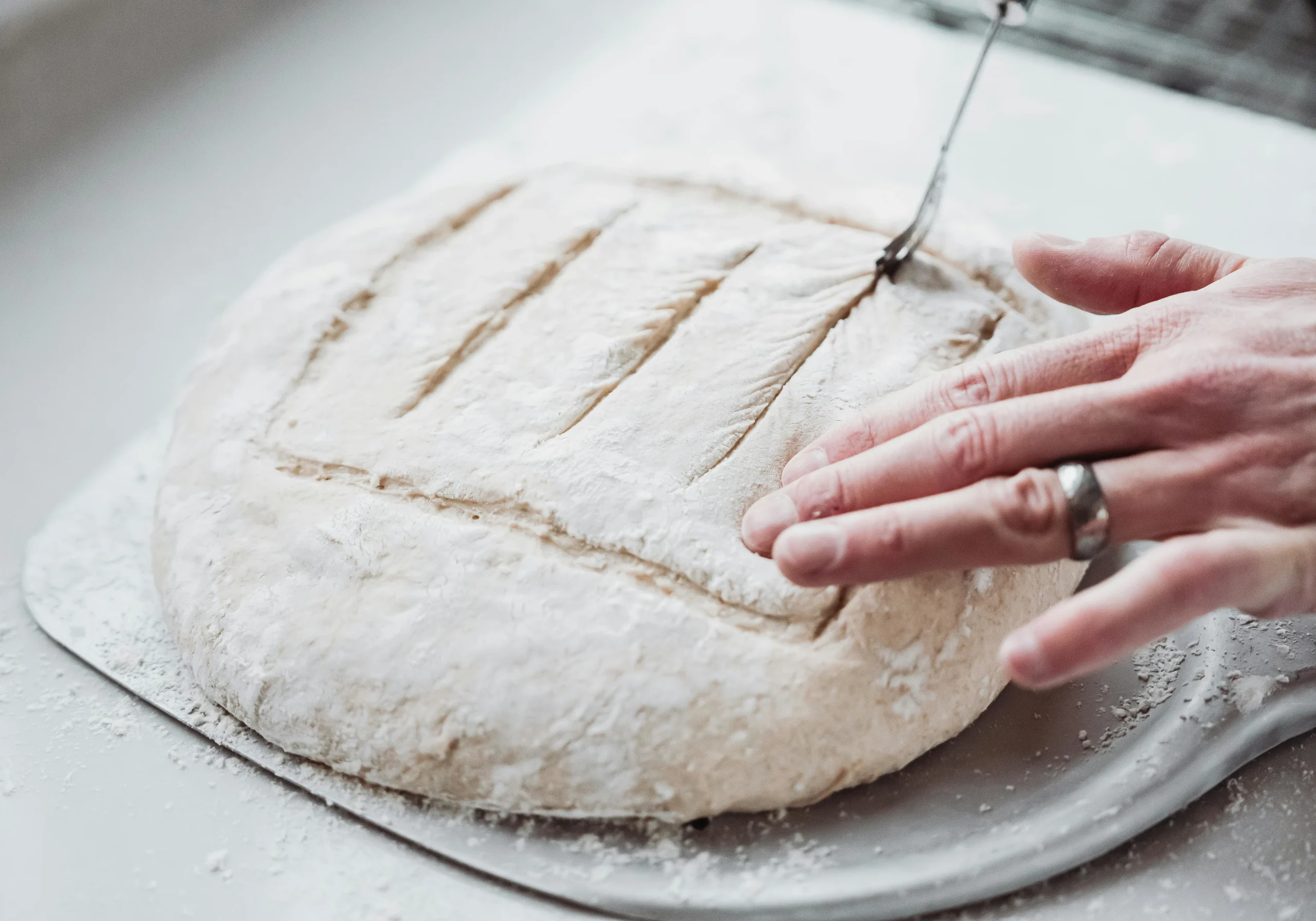
- Step 1: The Stem. Make one long, slightly curved cut down the center of the loaf. This should be a deep, functional score (about 1/2 inch) to allow for expansion.
- Step 2: The Leaves. Using just the tip of your blade, make short, shallow, angled cuts branching off the central stem. Keep these purely decorative, just skimming the surface of the dough.
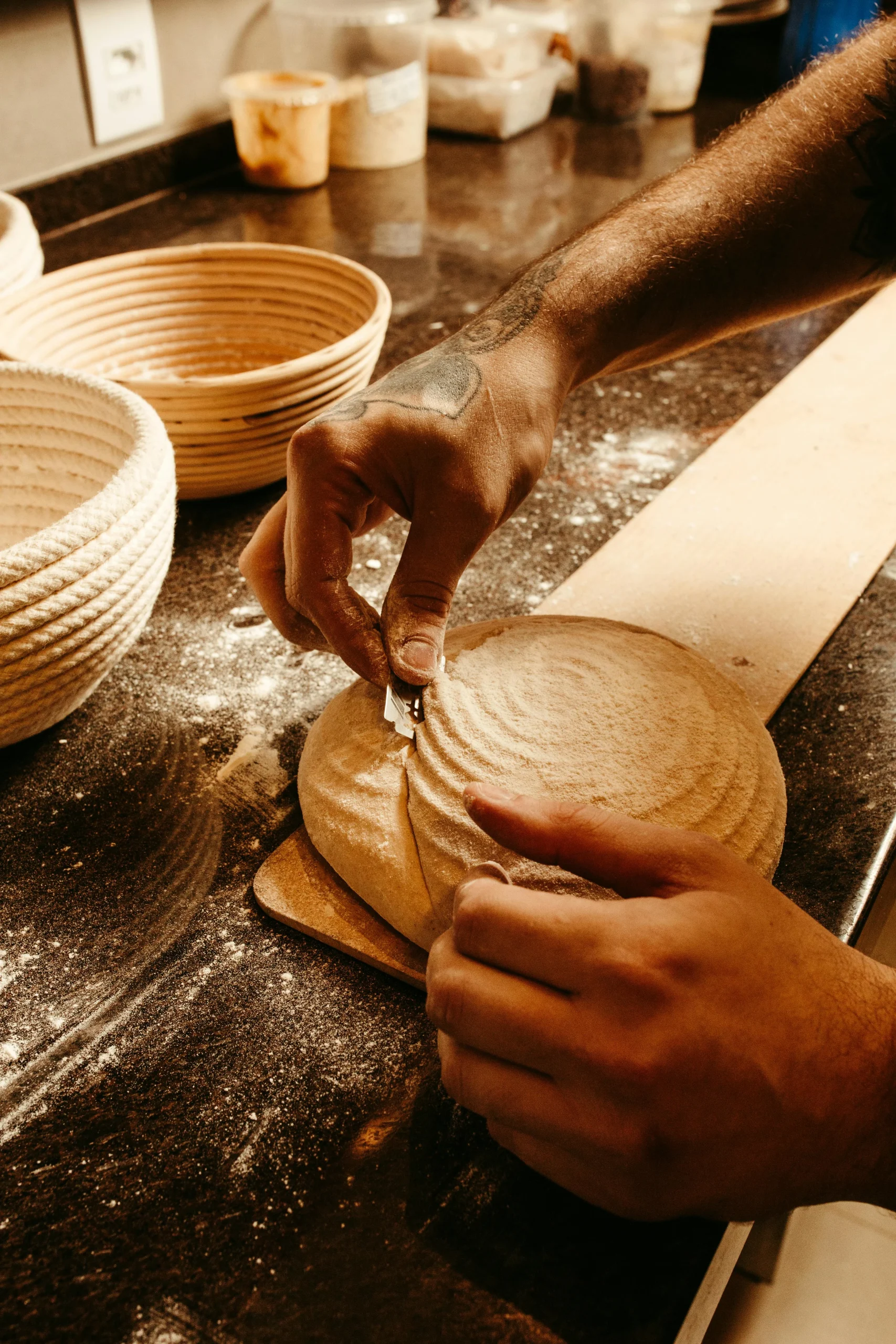
The Box Cut / Cross Pattern
This is a perfect, classic design for round boules. It provides even expansion across the entire loaf, resulting in a rustic, evenly opened crust rather than a single dramatic ear.
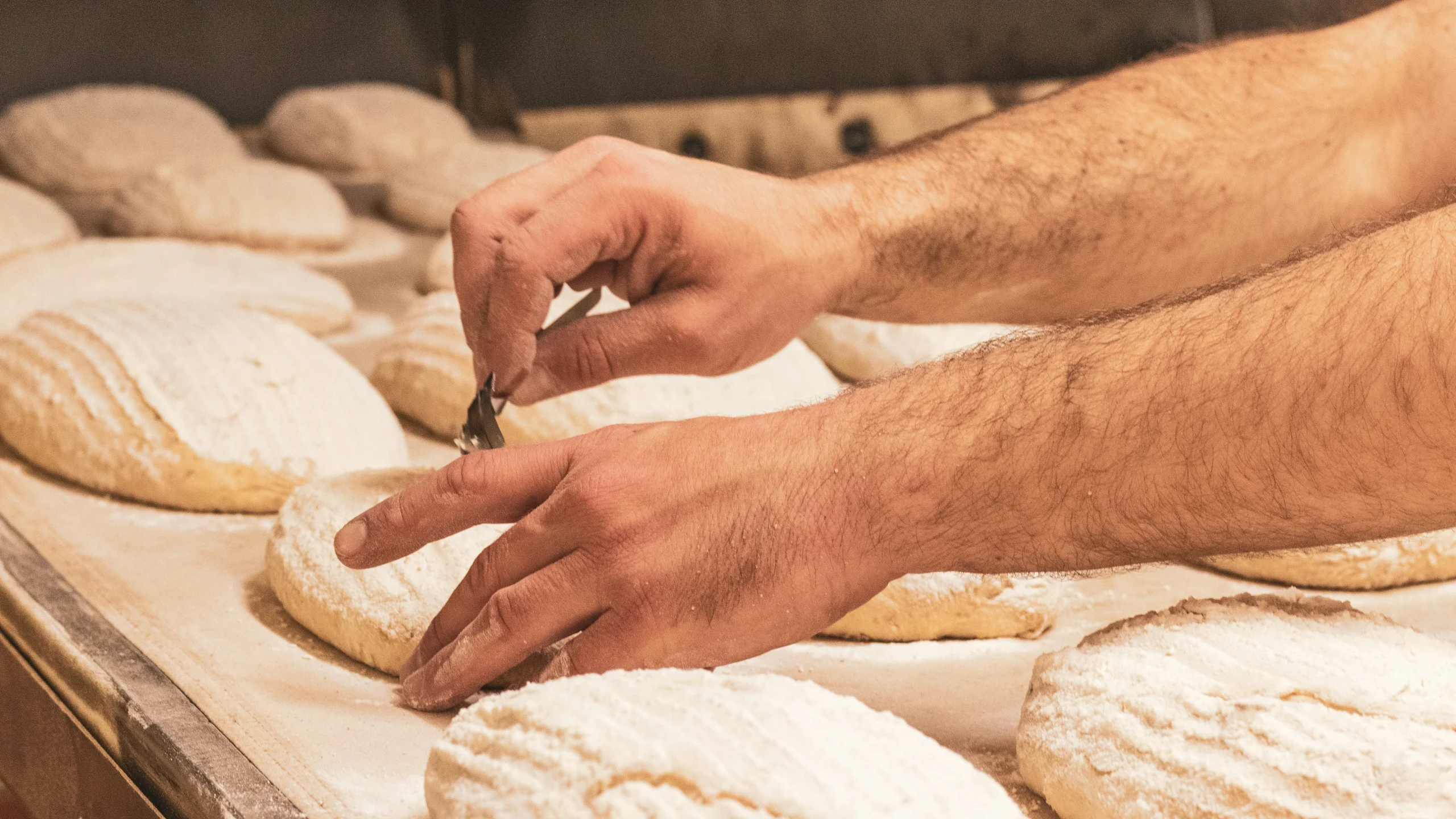
- Step 1: The First Cut. Hold your blade relatively straight (closer to 90 degrees). Make a deep, functional cut across the dough.
- Step 2: Complete the Pattern. Make intersecting cuts to form a square (“box”) or a simple “X” in the center. Ensure all cuts are of equal depth for even rising.
The Leaf Pattern
Turn your entire loaf into a beautiful, organic leaf shape. This design uses multiple functional cuts to create a symmetrical expansion.
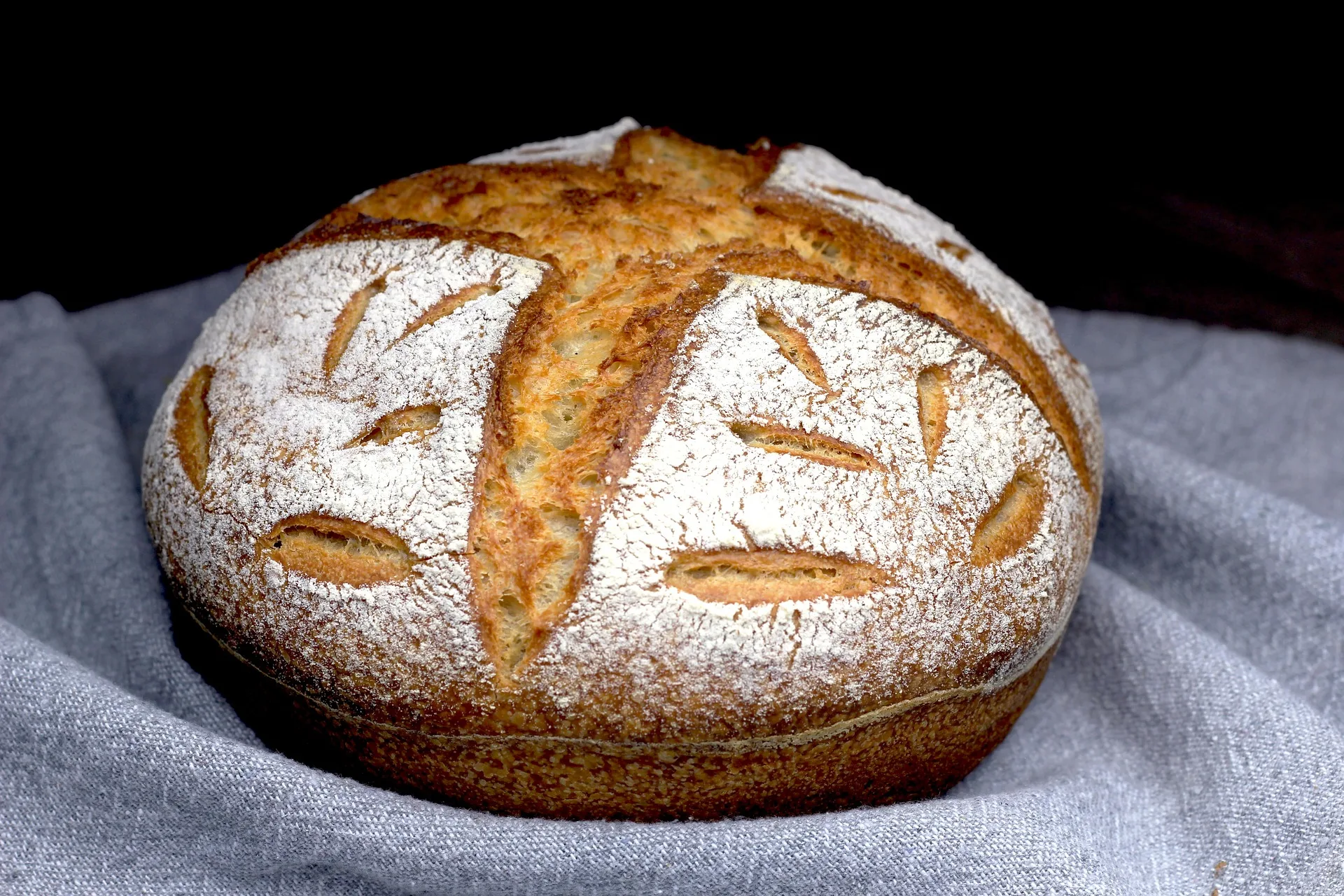
- Step 1: Visualize the Center. Picture a line down the center of your loaf (you can make a faint scratch with your blade as a guide).
- Step 2: Create the Veins. Make a series of deep, functional cuts starting near the center line and angling outwards, like the veins of a leaf. Repeat symmetrically on the other side. These cuts will open up significantly in the oven to create the leaf shape.
Decorative Combination Scores
This is where you can truly become an artist. These designs combine intricate, shallow “tattoos” with one primary, deep expansion cut.
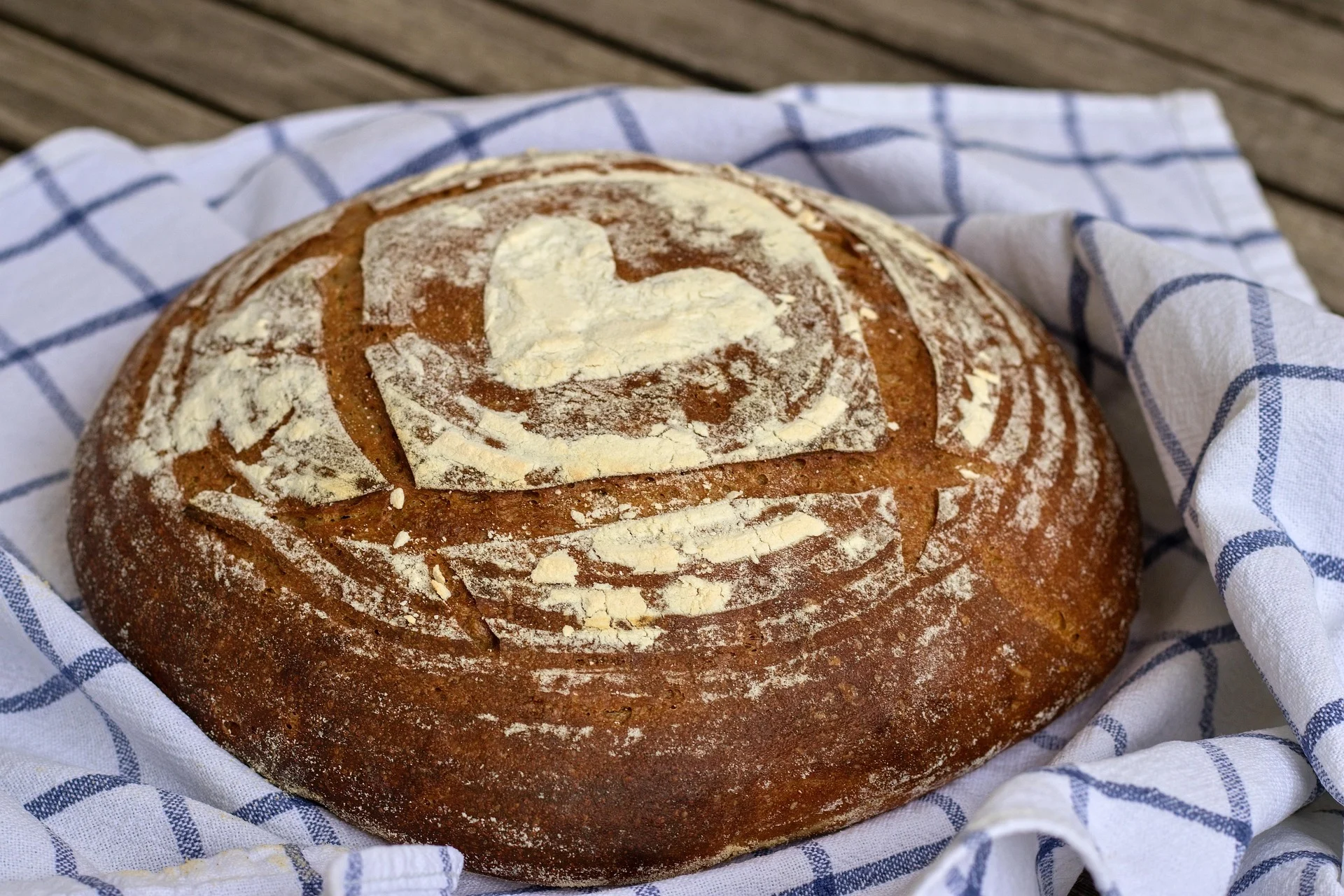
- Step 1: The Art (Shallow). Dust the loaf generously with flour so the design stands out. Use the very tip of a straight blade to draw your pattern. These must be very shallow, just barely breaking the skin. They should not expand.
- Step 2: The Function (Deep). Once your art is complete, you must make a deep, functional slash (like the basic single slash) to the side or center of the design. This directs the oven spring to that specific spot, protecting your delicate, shallow work from being distorted.
Common Scoring Problems & Solutions (Troubleshooting)
Even with the right technique, things can sometimes go wrong. If your results aren’t what you expected, don’t worry—the fix is usually simple.
Here are the solutions to the most common issues you’ll encounter when you score sourdough.
“My blade is dragging the dough!”
This is the most frequent problem, and it almost always comes down to one of two things.
First, check your dough temperature. A dragging blade is a classic sign that your dough is too warm and soft. For your next bake, ensure the loaf is thoroughly chilled and you score it immediately after taking it out of the fridge.
Second, check your blade. A dull blade, even a slightly used one, will snag rather than slice. Make sure you are using a fresh, razor-sharp blade for every baking session.
“My loaf didn’t get an ear!”
The coveted sourdough “ear” is the result of a very specific scoring technique. If yours is missing, the angle of your cut is the most likely culprit.
To create an ear, you must use a very shallow angle (around 30 degrees) to get under the skin of the dough. A cut that is too vertical (closer to 90 degrees) will simply split the loaf open without creating the flap needed for an ear. Also, ensure the cut is deep enough (about 1/2 inch) to provide a good hinge.
Finally, remember that a great score can’t fix a weak fermentation. An ear is a sign of powerful oven spring, which starts with a perfectly proofed loaf.
“My loaf burst open somewhere else!”
If your bread cracks or bursts on the side or bottom, it’s a clear sign that your primary score was not deep enough to act as the main vent.
The force of the oven spring will always find the weakest point to escape. Your job when scoring is to create that weakest point deliberately. If your score is too shallow, the pressure will build up and burst through a different, weaker part of the crust. For your main functional cut, be confident and commit to a depth of at least ¼ to ½ inch.
FAQ – How to Score Sourdough Bread
1) How deep should I score my sourdough?
For your main functional score—the one that controls the oven spring—you should aim for a depth of about ¼ to ½ inch. If you are making decorative cuts for a pattern, they should be very shallow, only deep enough to break the skin.
2) Do you score sourdough right before baking?
Yes, the best time to score sourdough is immediately before placing it in the oven. This ensures the dough is as cold and firm as possible, which allows for the cleanest possible cut without the dough spreading.
3) What happens if you don’t score sourdough?
If you don’t score your loaf, the pressure from the oven spring will build up and burst through the weakest point of the crust unpredictably. This often results in a less appealing, “blown-out” shape and can lead to a denser crumb.
4) Can I score sourdough with a regular kitchen knife?
You can, but only if your kitchen knife is exceptionally sharp and has a very thin blade. A dull or thick knife will drag and tear the delicate surface of the dough rather than slicing it cleanly, so razor-sharpness is the most important factor.
Conclusion: Score with Confidence
Mastering how to score sourdough bread is a journey, but it isn’t complicated. As we’ve learned, the secret isn’t just in the flick of the wrist; it’s a perfect combination of a strong foundation—a cold, well-fermented dough—and a swift, confident technique.
Don’t be afraid to practice. Start by perfecting the simple slash to create that beautiful ear, and as you get more comfortable, begin to experiment with the creative designs we’ve covered. Each loaf is a new canvas.